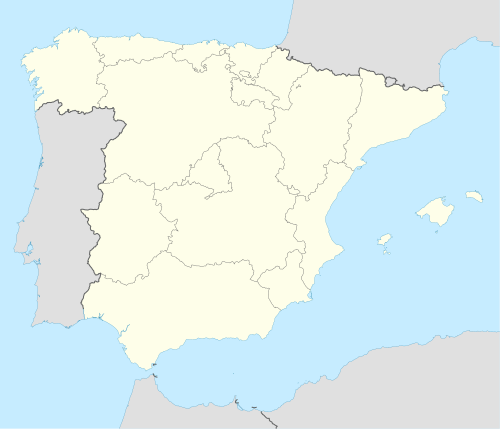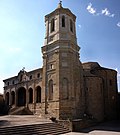| Name |
Location |
Autonomous Community |
Diocese |
Dedication[b] |
Notes |
Images |
| Cathedral of Saint John the Baptist |
Albacete |
 Castile-La Mancha Castile-La Mancha |
Albacete |
1955[8] |
|
 |
| Cathedral of the Saviour |
Albarracín |
 Aragon Aragon |
Teruel and Albarracín |
1600 |
|
 |
| Magistral Cathedral of Saint Justus and Saint Pastor |
Alcalá de Henares |
 Madrid Madrid |
Alcalá de Henares |
1991[9] |
 UNESCO World Heritage Site since 1998, as part of the site University and Historic Precinct of Alcalá de Henares.[10] Only church together with Saint Peter's of Leuven to have the rank of Magistral, as their canons are required to be doctors in Theology.[11] UNESCO World Heritage Site since 1998, as part of the site University and Historic Precinct of Alcalá de Henares.[10] Only church together with Saint Peter's of Leuven to have the rank of Magistral, as their canons are required to be doctors in Theology.[11] |
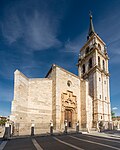 |
| Co-Cathedral of Saint Nicholas of Bari |
Alicante |
 Valencian Community Valencian Community |
Orihuela-Alicante |
1959[12] |
|
 |
| Cathedral of the Incarnation |
Almería |
 Andalusia Andalusia |
Almería |
1551[13] |
|
 |
| Cathedral of Saint Mary |
Astorga |
 Castile and León Castile and León |
Astorga |
1069[14] |
|
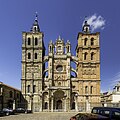 |
| Cathedral of the Saviour |
Ávila |
 Castile and León Castile and León |
Ávila |
|
 UNESCO World Heritage Site since 1985 as part of the site Old Town of Ávila with its Extra-Muros Churches.[15] UNESCO World Heritage Site since 1985 as part of the site Old Town of Ávila with its Extra-Muros Churches.[15] |
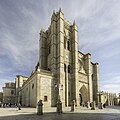 |
| Metropolitan Cathedral of Saint John the Baptist |
Badajoz |
 Extremadura Extremadura |
Mérida-Badajoz |
1276[16] |
|
 |
| Cathedral of Saint Mary of the Assumption |
Barbastro |
 Aragon Aragon |
Barbastro-Monzón |
1571[17] |
|
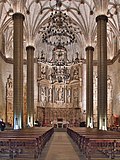 |
| Metropolitan Cathedral Basilica of the Holy Cross and Saint Eulalia |
Barcelona |
 Catalonia Catalonia |
Barcelona |
1058[c] |
|
 |
| Cathedral Basilica of Saint James |
Bilbao |
 Basque Country Basque Country |
Bilbao |
1955[19] |
 UNESCO World Heritage Site since 2015, as part of the site Routes of Santiago de Compostela: Camino Francés and Routes of Northern Spain.[20] UNESCO World Heritage Site since 2015, as part of the site Routes of Santiago de Compostela: Camino Francés and Routes of Northern Spain.[20] |
 |
| Metropolitan Cathedral Basilica of Saint Mary |
Burgos |
 Castile and León Castile and León |
Burgos |
1260[21] |
 UNESCO World Heritage Site since 1984,[22] Spain's first declared WHS.[23] UNESCO World Heritage Site since 1984,[22] Spain's first declared WHS.[23] |
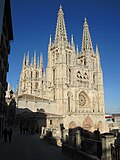 |
| Co-Cathedral of Saint Mary |
Cáceres |
 Extremadura Extremadura |
Coria-Cáceres |
1957[24] |
 UNESCO World Heritage Site since 1986, as part of the site Old Town of Cáceres.[25] UNESCO World Heritage Site since 1986, as part of the site Old Town of Cáceres.[25] |
 |
| Cathedral of the Holy Cross over the Waters |
Cádiz |
 Andalusia Andalusia |
Cádiz and Ceuta |
1838[26] |
|
 |
| Cathedral of Saint Mary |
Calahorra |
 La Rioja La Rioja |
Calahorra and La Calzada-Logroño |
|
|
 |
| Co-Cathedral of Saint Mary |
Castellón de la Plana |
 Valencian Community Valencian Community |
Segorbe-Castellón |
1961[27] |
|
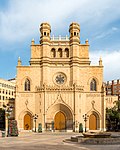 |
| Cathedral of the Assumption |
Ceuta |
 Ceuta Ceuta |
Cádiz and Ceuta |
1726[28] |
|
 |
| Cathedral Basilica of Saint Mary of the Prado |
Ciudad Real |
 Castile-La Mancha Castile-La Mancha |
Ciudad Real |
1981[29] |
Since 1875 it holds the title of priory of the military orders of Santiago, Alcántara, Calatrava and Montesa.[30] |
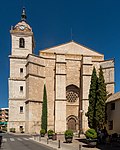 |
| Cathedral of Saint Mary |
Ciudad Rodrigo |
 Castile and Leon Castile and Leon |
Ciudad Rodrigo |
1160[21] |
|
 |
| Cathedral Basilica of Saint Mary |
Ciutadella |
 Balearic Islands Balearic Islands |
Menorca |
1795[31] |
|
 |
| Cathedral of the Assumption of our Lady |
Córdoba |
 Andalusia Andalusia |
Córdoba |
1236[32] |
 UNESCO World Heritage Site since 1984, and extended in 1994 to create the site Historic Centre of Cordoba.[33] Better known as the Mosque-Cathedral of Córdoba.[34] UNESCO World Heritage Site since 1984, and extended in 1994 to create the site Historic Centre of Cordoba.[33] Better known as the Mosque-Cathedral of Córdoba.[34] |
 |
| Cathedral of Saint Mary of the Assumption |
Coria |
 Extremadura Extremadura |
Coria-Cáceres |
1898[35] |
|
 |
| Cathedral of Saint Mary and Saint Julian |
Cuenca |
 Castile-La Mancha Castile-La Mancha |
Cuenca |
1196[36] |
 UNESCO World Heritage Site since 1996 as part of the site Historic Walled Town of Cuenca. It is considered the first gothic cathedral in Spain.[37] UNESCO World Heritage Site since 1996 as part of the site Historic Walled Town of Cuenca. It is considered the first gothic cathedral in Spain.[37] |
 |
| Cathedral of the Assumption of Mary |
El Burgo de Osma |
 Castile and Leon Castile and Leon |
Osma-Soria |
1272[38] |
|
 |
| Co-Cathedral of Saint Julian |
Ferrol |
 Galicia Galicia |
Mondoñedo-Ferrol |
1959[39] |
|
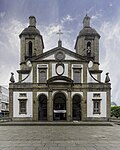 |
| Cathedral of Saint Mary Magdalene |
Getafe |
 Madrid Madrid |
Getafe |
1995[40] |
|
 |
| Cathedral of Saint Mary |
Girona |
 Catalonia Catalonia |
Girona |
1038[41] |
Widest gothic nave in the world at 23 m.[21] |
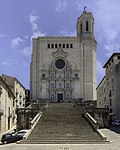 |
| Metropolitan Cathedral Basilica of the Incarnation |
Granada |
 Andalusia Andalusia |
Granada |
1946[d] |
Burial place of the Catholic Monarchs. |
 |
| Co-Cathedral of Saint Mary the Major |
Guadalajara |
 Castile-La Mancha Castile-La Mancha |
Sigüenza-Guadalajara |
1959[43] |
|
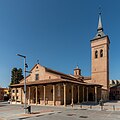 |
| Cathedral of the Incarnation |
Guadix |
 Andalusia Andalusia |
Guadix |
|
Guadix is traditionally considered the oldest episcopal see in Spain, founded by Saint Torquatus in the 1st century AD.[44] |
 |
| Cathedral of Our Lady of Mercy |
Huelva |
 Andalusia Andalusia |
Huelva |
1954[45] |
|
 |
| Cathedral of the Transfiguration of the Lord |
Huesca |
 Aragon Aragon |
Huesca |
1098[46] |
|
 |
| Cathedral of Our Lady of the Snows |
Ibiza |
 Balearic Islands Balearic Islands |
Ibiza |
1782[47] |
 UNESCO World Heritage Site since 1999 as part of the site Ibiza, Biodiversity and Culture.[48] UNESCO World Heritage Site since 1999 as part of the site Ibiza, Biodiversity and Culture.[48] |
 |
| Cathedral of Saint Peter |
Jaca |
 Aragon Aragon |
Jaca |
1063[49] |
|
 |
| Cathedral of the Assumption |
Jaen |
 Andalusia Andalusia |
Jaén |
1660[50] |
|
 |
| Cathedral of the Holy Saviour |
Jerez de la Frontera |
 Andalusia Andalusia |
Asidonia-Jerez |
1980[51] |
|
 |
| Cathedral of Saint Mary |
La Seu d'Urgell |
 Catalonia Catalonia |
Urgell |
1040[e] |
The town itself incorporated the cathedral to its name, being seo an alternate Latin name for cathedral church. Its bishop is one of the co-Princes of Andorra, ruling since 988.[53] |
 |
| Cathedral Basilica of Saint Anne |
Las Palmas |
 Canary Islands Canary Islands |
Canarias |
1871[54] |
|
 |
| Cathedral of Saint Mary |
León |
 Castile and Leon Castile and Leon |
León |
1303[55] |
|
 |
| Cathedral of the Assumption |
Lleida |
 Catalonia Catalonia |
Lleida |
1781[56] |
Commonly known as the New Cathedral of Lleida. |
 |
| Co-Cathedral of Saint Mary of La Redonda |
Logroño |
 La Rioja La Rioja |
Calahorra and La Calzada-Logroño |
1959[57] |
|
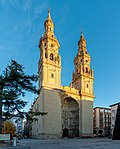 |
| Cathedral of the Assumption of Saint Mary |
Lugo |
 Galicia Galicia |
Lugo |
1273[21] |
 UNESCO World Heritage Site since 2015, as part of the site Routes of Santiago de Compostela: Camino Francés and Routes of Northern Spain.[20] UNESCO World Heritage Site since 2015, as part of the site Routes of Santiago de Compostela: Camino Francés and Routes of Northern Spain.[20] |
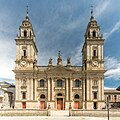 |
| Metropolitan Cathedral of Saint Mary the Royal of La Almudena |
Madrid |
 Madrid Madrid |
Madrid |
1993[58] |
Only cathedral in Spain and first one outside Rome to be consecrated by a pope.[59] |
 |
| Cathedral of the Armed Forces |
Madrid |
 Madrid Madrid |
Military Archbishopric of Spain |
1985[60] |
|
 |
| Cathedral Basilica of the Incarnation |
Málaga |
 Andalusia Andalusia |
Málaga |
1588[61] |
|
 |
| Metropolitan Co-Cathedral of Saint Mary the Major |
Mérida |
 Extremadura Extremadura |
Mérida-Badajoz |
2006[f] |
|
 |
| Cathedral Basilica of the Virgin of the Assumption |
Mondoñedo |
 Galicia Galicia |
Mondoñedo-Ferrol |
1246[63] |
 UNESCO World Heritage Site since 2015, as part of the site Routes of Santiago de Compostela: Camino Francés and Routes of Northern Spain.[20] UNESCO World Heritage Site since 2015, as part of the site Routes of Santiago de Compostela: Camino Francés and Routes of Northern Spain.[20] |
 |
| Co-Cathedral of Saint Mary of the Romeral |
Monzón |
 Aragon Aragon |
Barbastro-Monzón |
1998[64] |
|
 |
| Cathedral of Saint Mary |
Murcia |
 Murcia Murcia |
Cartagena |
1467[65] |
|
 |
| Cathedral of the Saviour and Saint Mary |
Orihuela |
 Valencian Community Valencian Community |
Orihuela-Alicante |
1510[66] |
|
 |
| Cathedral of Saint Martin |
Ourense |
 Galicia Galicia |
Ourense |
1188[67] |
|
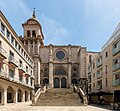 |
| Metropolitan Cathedral Basilica of the Holy Saviour |
Oviedo |
 Asturias Asturias |
Oviedo |
821[68] |
 UNESCO World Heritage Site since 2015, as part of the site Routes of Santiago de Compostela: Camino Francés and Routes of Northern Spain.[20] Its Cámara Santa (Holy Chamber) was previously designated in 1998, as part of site Monuments of Oviedo and the Kingdom of the Asturias.[69] UNESCO World Heritage Site since 2015, as part of the site Routes of Santiago de Compostela: Camino Francés and Routes of Northern Spain.[20] Its Cámara Santa (Holy Chamber) was previously designated in 1998, as part of site Monuments of Oviedo and the Kingdom of the Asturias.[69] |
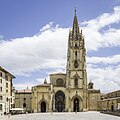 |
| Cathedral Basilica of Saint Antoninus |
Palencia |
 Castile and Leon Castile and Leon |
Palencia |
1897[g] |
Third largest in total area in Spain.[71] |
 |
| Cathedral Basilica of Saint Mary |
Palma |
 Balearic Islands Balearic Islands |
Majorca |
1346[21] |
Its gothic rose window is the largest in the world, at 13 m.[72] |
 |
| Metropolitan Cathedral of Saint Mary of the Assumption |
Pamplona |
 Navarre Navarre |
Pamplona and Tudela |
1127[21] |
|
 |
| Cathedral of the Assumption of our Lady |
Plasencia |
 Extremadura Extremadura |
Plasencia |
1578[73] |
A complex of two cathedrals, an old and a new one, both unfinished and adjacent to each other.[74] |
 |
| Cathedral of Saint Mary of the See |
Salamanca |
 Castile and Leon Castile and Leon |
Salamanca |
|
 UNESCO World Heritage Site since 1988 as part of the site Old City of Salamanca.[75] Better known as the Old Cathedral. UNESCO World Heritage Site since 1988 as part of the site Old City of Salamanca.[75] Better known as the Old Cathedral. |
 |
| Cathedral of the Assumption of the Virgin |
Salamanca |
 Castile and Leon Castile and Leon |
Salamanca |
1733[76] |
 UNESCO World Heritage Site since 1988 as part of the site Old City of Salamanca.[75] Better known as the New Cathedral. UNESCO World Heritage Site since 1988 as part of the site Old City of Salamanca.[75] Better known as the New Cathedral. |
 |
| Cathedral of Our Lady of Los Remedios |
San Cristóbal de La Laguna |
 Canary Islands Canary Islands |
San Cristóbal de La Laguna |
1819[77] |
 UNESCO World Heritage Site since 1999 as part of the site San Cristóbal de La Laguna.[78] UNESCO World Heritage Site since 1999 as part of the site San Cristóbal de La Laguna.[78] |
 |
| Cathedral of the Good Shepherd |
San Sebastian |
 Basque Country Basque Country |
San Sebastian |
1953[79] |
|
 |
| Cathedral of Saint Lawrence |
Sant Feliu de Llobregat |
 Catalonia Catalonia |
Sant Feliu de Llobregat |
2004[80] |
|
 |
| Cathedral Basilica of Our Lady of the Assumption |
Santander |
 Cantabria Cantabria |
Santander |
1754[81] |
|
 |
| Metropolitan Cathedral Basilica of Saint James the Apostle |
Santiago de Compostela |
 Galicia Galicia |
Santiago de Compostela |
1211[82] |
 UNESCO World Heritage Site since 1985, as part of the site Santiago de Compostela (Old Town).[83] Traditionally regarded as the burial place of the apostle James the Great, and the subject of pilgrimage for centuries. Depicted on Spanish 1, 2 and 5 Euro cent coins.[84] UNESCO World Heritage Site since 1985, as part of the site Santiago de Compostela (Old Town).[83] Traditionally regarded as the burial place of the apostle James the Great, and the subject of pilgrimage for centuries. Depicted on Spanish 1, 2 and 5 Euro cent coins.[84] |
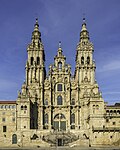 |
| Cathedral of the Saviour and Saint Mary |
Santo Domingo de la Calzada |
 La Rioja La Rioja |
Calahorra and La Calzada-Logroño |
1232[85] |
|
 |
| Cathedral Basilica of the Assumption of Our Lady |
Segorbe |
 Valencian Community Valencian Community |
Segorbe-Castellón |
1534[86] |
The interior was fully renovated between 1791 and 1795, becoming the only cathedral in the Academic style in Spain.[87] |
 |
| Cathedral of Our Lady of the Assumption and of Saint Fructus |
Segovia |
 Castile and Leon Castile and Leon |
Segovia |
1768[88] |
 UNESCO World Heritage Site since 1985 as part of the site Old Town of Segovia and its Aqueduct.[89] UNESCO World Heritage Site since 1985 as part of the site Old Town of Segovia and its Aqueduct.[89] |
 |
| Metropolitan Cathedral of Saint Mary of the See |
Seville |
 Andalusia Andalusia |
Seville |
1507[90] |
 UNESCO World Heritage Site since 1987, as part of the site Cathedral, Alcázar and Archivo de Indias in Seville.[91] Largest gothic cathedral in the world.[92] UNESCO World Heritage Site since 1987, as part of the site Cathedral, Alcázar and Archivo de Indias in Seville.[91] Largest gothic cathedral in the world.[92] |
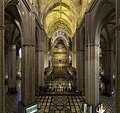 |
| Cathedral Basilica of Saint Mary |
Sigüenza |
 Castile-La Mancha Castile-La Mancha |
Sigüenza-Guadalajara |
1169[93] |
|
 |
| Cathedral of Saint Mary |
Solsona |
 Catalonia Catalonia |
Solsona |
1593[94] |
|
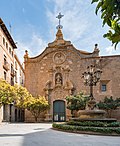 |
| Co-Cathedral of Saint Peter |
Soria |
 Castile and Leon Castile and Leon |
Osma-Soria |
1959[95] |
Stills keep the older, Romanesque, cloister from the 12th century from a previous church that fell down around 1543. It was replaced with the current, Gothic building.[96] |
 |
| Cathedral of Saint Mary of La Huerta |
Tarazona |
 Aragon Aragon |
Tarazona |
1235[97] |
Reopened in 2011 after a 30-year renovation that rediscovered a set of al fresco paintings from the 1540s showing nude mythological creatures, a unique feature for a cathedral in Europe.[98] |
 |
| Primatial Metropolitan Cathedral Basilica of Saint Thecla |
Tarragona |
 Catalonia Catalonia |
Tarragona |
1331[99] |
|
 |
| Cathedral of the Holy Spirit |
Terrassa |
 Catalonia Catalonia |
Terrassa |
2004[100] |
|
 |
| Cathedral of Saint Mary of Mediavilla |
Teruel |
 Aragon Aragon |
Teruel and Albarracín |
1587[101] |
 UNESCO World Heritage Site since 1986 as part of the site Mudéjar architecture of Aragon (specifically its bell tower, lantern tower, and wooden ceiling).[102] UNESCO World Heritage Site since 1986 as part of the site Mudéjar architecture of Aragon (specifically its bell tower, lantern tower, and wooden ceiling).[102] |
 |
| Primatial Metropolitan Cathedral of Saint Mary of the Assumption |
Toledo |
 Castile-La Mancha Castile-La Mancha |
Toledo |
1493[103] |
 UNESCO World Heritage Site since 1986 as part of the site Historic City of Toledo.[104] Since 1088, it holds the honorific title of Primatial, granted by Urban II, establishing a higher rank over the rest in the Iberian Peninsula.[105] UNESCO World Heritage Site since 1986 as part of the site Historic City of Toledo.[104] Since 1088, it holds the honorific title of Primatial, granted by Urban II, establishing a higher rank over the rest in the Iberian Peninsula.[105] |
 |
| Cathedral Basilica of Saint Mary |
Tortosa |
 Catalonia Catalonia |
Tortosa |
1441[106] |
|
 |
| Cathedral of Saint Mary the Major |
Tudela |
 Navarre Navarre |
Pamplona and Tudela |
1782[107] |
|
 |
| Cathedral of Saint Mary of the Assumption |
Tui |
 Galicia Galicia |
Tui-Vigo |
1225[108] |
|
 |
| Metropolitan Cathedral Basilica of the Assumption of our Lady |
Valencia |
 Valencian Community Valencian Community |
Valencia |
1238[109] |
Claims to house the Holy Grail since 1437.[110] |
 |
| Metropolitan Cathedral of our Lady of the Assumption |
Valladolid |
 Castile and Leon Castile and Leon |
Valladolid |
1668[111] |
Originally projected to be the largest cathedral in Christendom, it was left unfinished when less than half of the building was built.[112] |
 |
| Cathedral Basilica of Saint Peter |
Vic |
 Catalonia Catalonia |
Vic |
1803[113] |
|
 |
| Co-Cathedral Basilica of Saint Mary |
Vigo |
 Galicia Galicia |
Tui-Vigo |
1959[114] |
|
 |
| Cathedral of Saint Mary |
Vitoria-Gasteiz |
 Basque Country Basque Country |
Vitoria |
1863[115] |
 UNESCO World Heritage Site in 2015, as part of the Routes of Santiago de Compostela: Camino Francés and Routes of Northern Spain.[20] Commonly known as the "Old cathedral". UNESCO World Heritage Site in 2015, as part of the Routes of Santiago de Compostela: Camino Francés and Routes of Northern Spain.[20] Commonly known as the "Old cathedral". |
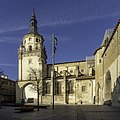 |
| Cathedral of Mary Immaculate |
Vitoria-Gasteiz |
 Basque Country Basque Country |
Vitoria |
1969[116] |
Commonly known as the "New cathedral". Second largest cathedral in Spain, by area, after Seville.[116] |
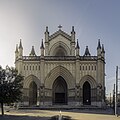 |
| Cathedral of the Saviour |
Zamora |
 Castile and Leon Castile and Leon |
Zamora |
1174[117] |
|
 |
| Metropolitan Cathedral of the Saviour |
Zaragoza |
 Aragon Aragon |
Zaragoza |
1318[118] |
 UNESCO World Heritage Site since 2001 as part of the extension of the site Mudéjar architecture of Aragon.[102] UNESCO World Heritage Site since 2001 as part of the extension of the site Mudéjar architecture of Aragon.[102] |
 |
| Cathedral Basilica of Our Lady of the Pillar |
Zaragoza |
 Aragon Aragon |
Zaragoza |
1676[119] |
With an estimated 5 million visitors in 2015, it's one of the most visited monuments in Spain.[120] |
 |
|
